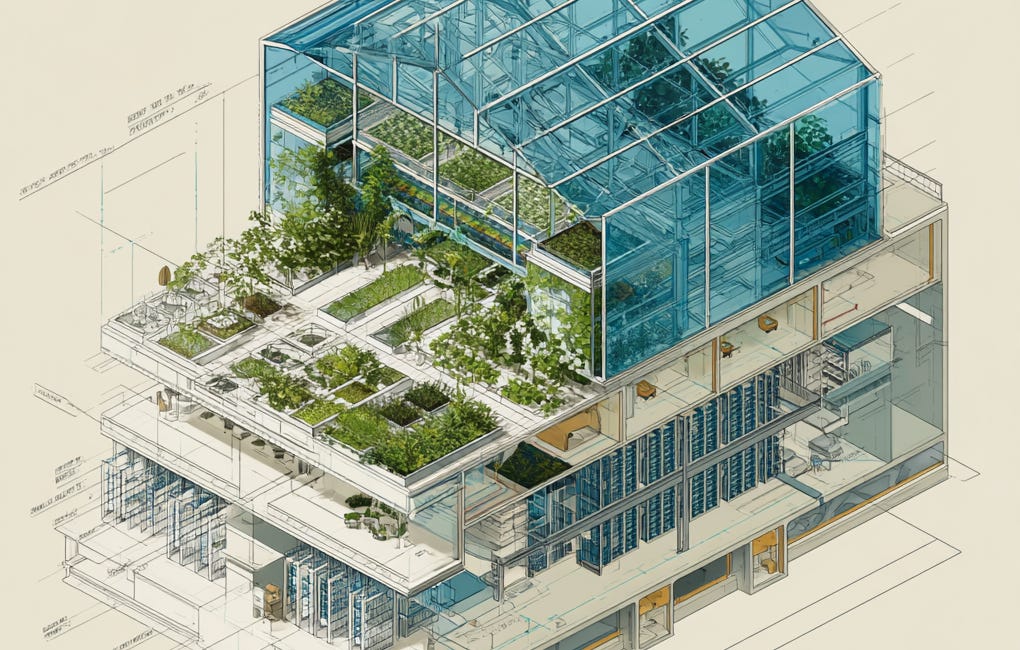Computational Concrete should be a foundational principal of data center design
A quick look into integration of phase-change materials into data center foundations to increase operational efficiency of HVAC and mechanical cooling systems to counteract thermal spikes.
As the demand for data and cloud computing explodes, cooling remains one of the largest operational expenses and environmental burdens in data center design. The building specification and design needs to be continuously refined and iterated towards the most stable and sustainable use case.
The cooling system is one of critical importance; and a significant contributor in the capital and operational expense in data center construction and management. One of the issues which the cooling system must contend with is that of thermal spikes during periods of peak computation. Suddenly, a system is required to spool up to run at maximum, or even supraoptimal, capacity. Such a draw on the electrical distribution can additionally increase risks of circuit overload, throttling and even cause the power to trip.
In order to stabilize the ambient temperature - and subsequently the demand on the HVAC or cooling systems - the easiest method is to provide a heatsink to absorb excess enery in periods of spiked compute.
A novel approach could be the introduction and integration of phase-change foundations: a concept where the building’s concrete foundations are embedded with phase-change materials (PCMs) that act effectively as a giant thermal battery, absorbing excess heat during peak computation, and releasing it during cooler periods or when energy is more scarce.
Phase-Change Materials: A solid base for foundational integration
Phase-change materials (PCMs) absorb and release large quantities of latent heat when they undergo a phase transition — typically between solid and liquid phase. During this transition, they store heat at nearly constant temperatures.
In data center applications, this, in theory, will translate into:
Peak loads cause PCMs to melt, absorbing thermal spikes passively.
Cooler, off-peak periods allow PCMs to solidify, releasing heat slowly and evenly.
This thermal cycle flattens demand on mechanical cooling systems and acts as a thermal buffer integrated directly into the building.
Eutectic Metal Alloys could be a particularly promising phase-change solution
While many PCMs operate in the 20-40°C range, eutectic metal alloys present an exciting class of materials for higher-temperature thermal buffering. These alloys are mixtures of metals that melt and solidify at a single, sharp eutectic point, making them highly stable for repeated phase transitions.
There are a handful of relatively well-researched and documented EMAs that could be suitable:
It's quite likely that a hybridized approach may be adopted; EMAs could attract a relatively high cost component, and therefore their placement should bve specific to the direct environment.
Other suitable phase-change materials
Paraffin Waxes [Melting Point: 20-60°C] -Stable and cheap; but low conductivity and flammable.
Salt Hydrates [Melting Point: 28-35°C] - High heat storage; but a high risk of phase separation in exposure to higher temperatures.
Bio-based Fatty Acids [Melting point varies on fatty-acids used] - A renewable and more sustainable solution; but limited thermal range, variable purity and more prone to degradation over time.
This is to suggest that parts of the structure which has less exposure to heat could easily substitute EMAs for more economic phase-change materials with lower melting points, such as paraffin waxes (this would likely have to be encapsulated within the concrete structure). EMAs with appropriate melting points (Bismuth-Tin, Bi-SN; or Indium-Tin, In-Sn) could be embedded on zones of the building with a higher exposure to heat generation, such as the main server storage or generator rooms.
Note: Lead-based alloys may face restrictions in certain regions due to RoHS compliance. Alternatives like Bi–Sn or In–Sn are preferred for environmental safety.
Construction integration and deployment
Eutectic alloys are not typically mixed into concrete directly, mainly due to corrosion and chemical incompatibility; but are suggested to be integrated in a variety of ways:
Encapsulated in high-conductivity shells (e.g., stainless steel, aluminum, or graphite composites)
Arranged as modular thermal cartridges or embedded tubes within the foundation or under raised floors
These encapsulated PCM modules are integrated into the slab (on-grade), or potentially into wall cores or cavities. Active airflow or fluid loops can assist in heat exchange with the surrounding structure.
Impacts on ambient temperature control in practice
High Thermal Density - With latent heat capacities an order of magnitude higher than concrete alone, eutectic metal alloys store more energy in less space than alternative PCMs.
Thermal Lag - By absorbing high-temperature spikes (~120-150°C) from equipment exhausts, they reduce the thermal gradient reaching HVAC systems.
Temperature Stability - Creates a buffer zone for ambient air, reducing fluctuations by up to 5-8°C, easing strain on cooling units.
Redundancy Value: In the event of HVAC failure, alloy-PCM foundations can delay critical overheating by approximately 15–30 minutes, enabling safer shutdowns and failovers.
Indicative figures, efficiency and examples
Latent heat storage:
Paraffin wax PCM: ~200 kJ/kg
Salt hydrates: 250-300 kJ/kg
Eutectic metals: 40-100 kJ/kg, but with 3-5x higher density
Storage energy density:
Bismuth-Tin (Bi–Sn) EMA ~475 MJ/m³ (vs. paraffin wax ~140 MJ/m³)
Thermal conductivity:
Bi–Sn: ~16-25 W/m·K (vs. paraffin wax: ~0.2 W/m·K)
In practice, this means that a Bismuth-Tin (Bi-Sn) EMA would allow a faster response to rapid load changes.
Benefits and Drawbacks
The novel foun dational integration of phase-change materials addresses:
Flattening out peak thermal loads - Eutectic metals excel over other PCMs at heat absorption - ideally suited to buffering high-temperature exhaust outputs from dense compute clusters
Reduction in cooling costs: The thermal 'lag' created by the absoprtion and slow release of energy reduces peak HVAC draw
Structural synergy: Makes building mass dual-purpose - support and energy storage
Potential for energy recycling: Released heat could be redirected or used to drive thermoelectric generators.
This is likely not a silver bullet, but forming part of a wider HVAC and mechanical cooling solution. Drawbacks are generally minimal and generally surmountable, but should be considered:
Material compatibility - Direct embedding in concrete is not viable for metal (and many other) PCMs - typically requiring encapsulation to be successfully deployed with no adverse chemical or corrosive effects.
Cost - Bi-Sn or In-Sn alloys are expensive; economic return on investment will depend predominantly on life cycle energy savings.
Design complexity - Adds modeling and maintenance requirements
Weight - High density adds structural load; must be factored into foundation design
Embedding thermal memory into the fabric of data center structures could transform how we design and operate at scale. Data centers that stabilize their own climate, intelligently and passively, could usher in a new generation of thermally aware architecture - where energy isn’t just consumed, but stored and recycled.
TH
You may also find these of interest:
The Diamond-Standard of Server Architecture: A crystalline concept that calls time on the idea of racks
The repercussions of exponential data growth is starting to collide with the physical and thermal limits of traditional infrastructure. As with many of the challenges with the current development of data center design, there's an increasingly large dependence on other professions and infrastrcture providers to either innovate or implement the required s…
Foam Sweet Foam: Why porous ceramic walls are the breath of fresh air data centers need
When we're designing things to fit into our modern environment, we often seem to overlook the obvious sources of inspiration, often hiding in plain sight. For many applications, teh best solutions for withstanding environmental considerations should probably begin with an animal or plant that has survived within it for several thousand millennia, long b…
A Hot Take, from Bits to Beets: how data centers could be growing our lunch for free
This started out as a shower thought; but the more I think about it the more I'm becoming obsessed with it.







